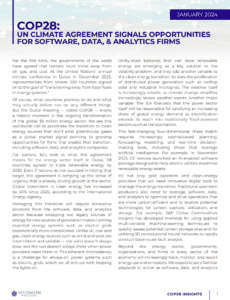 COP28: UN Climate Agreement Signals Opportunities for Software, Data, & Analytic Firms
COP28: UN Climate Agreement Signals Opportunities for Software, Data, & Analytic Firms
For the first time, the governments of the world have agreed that nations must move away from oil, gas, and coal. At the United Nations’ annual climate conference in Dubai in December 2023, representatives from almost 200 countries signed on to the goal of “transitioning away from fossil fuels in energy systems.”
Of course, what countries promise to do and what they actually deliver can be very different things. But the Dubai meeting — called COP28 — marks a historic moment in the ongoing transformation of the global $6 trillion energy sector. We see this worldwide call to accelerate the transition to clean energy sources that don’t emit greenhouse gases as a global market signal pointing to growing opportunities for firms that enable that transition, including software, data, and analytics companies.
For starters, let’s look at what this agreement means for the energy sector itself. In Dubai, 118 countries agreed to triple renewable energy by 2030. Even if nations do not succeed in hitting that target, the agreement is ramping up the sense of urgency that is already driving growth in the sector. Global investment in clean energy has increased by 40% since 2020, according to the International Energy Agency.
Managing this transition will require innovative solutions from the software, data, and analytics sector because swapping out legacy sources of energy for new sources of generation makes running essential energy systems such as electric grids exponentially more complicated. Unlike oil, coal and gas, clean energy sources such as wind and solar are intermittent and variable — the wind doesn’t always blow and the sun doesn’t always shine when power providers need them to. This inherent inconsistency is a challenge for always-on power systems such as electric grids, which we all entrust with keeping the lights on.
Utility-scale batteries that can store renewable energy are emerging as a key solution to the volatility problem, and they add another variable to the clean energy transition. So does the proliferation of distributed power generation such as rooftop solar and industrial microgrids. The weather itself is increasingly volatile, as climate change amplifies increasingly severe weather events. Another major variable: The IEA forecasts that the power sector itself will be responsible for satisfying an increasing share of global energy demand as electrification extends its reach into traditionally fossil-powered sectors such as transportation.
This fast-changing four-dimensional chess match requires increasingly sophisticated planning, forecasting, modeling, and real-time decision-making tools, including those that leverage artificial intelligence. For example, in November 2023, GE Venova launched an AI-enabled software package designed to help electric utilities maximize renewable energy assets.
It’s not only grid operators and clean-energy providers that will need innovative digital tools to manage the energy transition. Traditional upstream producers also need to leverage software, data, and analytics to optimize and drive operations that are more carbon-efficient and to explore potential technologies for carbon capture, utilization, and storage. For example, S&P Global Commodities Insights has developed methods for using applied multi-variable machine-learning techniques to quickly assess potential carbon storage sites and for utilizing 3D convolutional neural networks to rapidly conduct basin-scale fault analysis.
Beyond the energy sector, governments, organizations, and firms in every sector of the economy will increasingly track, monitor, and report energy use and emissions. We expect to see a familiar playbook in action as software, data, and analytics startups proliferate, nimbly creating point solutions and quickly adapting to regulatory and economic changes. As we’ve seen in sector after sector, we expect larger players to consolidate many of these efforts and plug gaps via mergers, acquisitions, and partnerships. Some will have the goal of creating platforms and solutions that serve the entire low-carbon energy ecosystem — from producers to ratepayers, and from regulators to carbon markets. We might see the emergence of the Zoom or Uber of the clean energy transition.
Transforming the energy sector will continue to demand innovation on a grand scale. A few Q4 2023 deals give a sense of their value:
- We advised private equity fund Spectrum Equity on its purchase of a 20% stake in Benchmark Mineral Intelligence. Benchmark provides information and pricing on lithium and other minerals critical to the energy transition.
- Private equity funds affiliated with Blackstone and Vista Equity Partners acquired Energy Exemplar in a deal that sources told Reuters is worth $1 billion. Energy Exemplar provides energy market simulation software that supports grid reliability and the energy transition for utilities, power producers, grid system operators, and others.
- Hitachi Energy acquired a controlling stake of eks Energy, which supplies energy management solutions for storage and renewables integration. The acquisition is designed to advance Hitachi’s battery energy storage systems to serve a BESS market that is expected to grow at least 20% per year through 2030.
Our view is that COP28 signals a tailwind for software, data, and analytics companies as organizations, governments, and businesses look to monitor, report, and benchmark their energy use according to increasingly stringent criteria. The demand for innovative solutions for climate and energy monitoring, mitigation, adaptation, and resilience will increase dramatically, as will the use of AI as companies look to reduce emissions, improve resource efficiency, and build resilience to the impacts of climate change.
Click below to read the article from the Technology Group.
Read the Article


